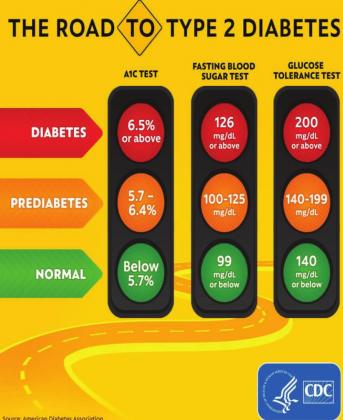PATIENTS OFTEN TELL ME they have a touch of “sugar,” which I find humorous. What they’re really trying to express is that they have been told their fasting blood sugar is a little higher than normal but not high enough to be diagnosed with type 2 diabetes. This condition is called prediabetes, and some 88 million Americans—more than one in three adults—have it. Of those who are already prediabetic, more than 80% aren’t even aware of it.
Awareness of prediabetes is important for the obvious reason that having it increases your chances of developing type 2 diabetes down the road. However, what might be less obvious is that this condition also puts you at increased risk of heart disease and stroke.
Type 2 diabetes is often referred to as a disease of lifestyle, so if this is true, making lifestyle changes should help prevent or delay type 2 diabetes and other health problems. But before we delve into that, let’s take a closer look at what prediabetes is and how it’s diagnosed.
When you have prediabetes, the cells in your body do not respond normally to insulin—the hormone produced by the pancreas that travels in the blood stream and allows sugar to enter the cells where it’s used for energy. Eventually, the pancreas can no longer make enough insulin to keep pace with the amount of sugar in the bloodstream, so blood sugar rises above a healthy level.
A simple blood test is used for screening and diagnosis, and a fasting blood sugar level of 100-125 mg/dl or an A1C of 5.7-6.4 indicates prediabetes. As I mentioned, you can have prediabetes for years with no obvious symptoms, so all too often it goes undetected until serious health problems arise and a diagnosis of type 2 diabetes is made.
To monitor for prediabetes or to determine whether you already have the condition, it important to visit your doctor once a year and to discuss getting tested for prediabetes if you have any of the following risk factors: overweight/obesity, over 45 years old, family history of diabetes, sleep apnea, sedentary lifestyle, gestational diabetes, or tobacco use. Race and ethnicity also play a role, with African Americans, Hispanic/Latino Americans, American Indians, Pacific Islanders, and Asian Americans being at higher risk.
With that said, let’s move on to the role of lifestyle. Making certain lifestyle changes can lower your risk of developing diabetes by as much as 58% for those under 60 years old and as much as 70% for those over 60 years old. Here are the five most important changes you can make from the standpoint of diabetes prevention and management:
1. Eat healthier— use the USDA’s MyPlate method for a good visual of a well-balanced diet. That is, make half your plate fruits and vegetables; one quarter of your plate healthy protein such as fish, poultry, beans, and nuts; and one quarter of your plate whole grains/starchy foods like brown rice, potatoes, and whole-grain pasta. If you drink dairy, choose fat-free milk or switch to soy milk.
2. Move it—find time to exercise at least 30 minutes a day, avoid sitting, and incorporate strength training into your exercise regimen two times a week.
3. Manage stress—stress is an unavoidable part of life, but our reaction to stress and our inability to deal with it successfully can really cause problems. We all have ways of dealing with stress, but examples of healthier coping mechanisms are yoga, meditation, walking in nature, and breathing exercises.
4. Get your sleep—a good night’s sleep is so important when to comes to restoring your body. Muscle growth, tissue repair, and protein synthesis all occur while we’re sleeping. In contrast, studies show that poor sleep takes a toll on our bodies in a variety of ways, including contributing to obesity, diabetes, high blood pressure, and heart disease. Adults should strive to get seven to eight hours of sleep per night.
5. Avoid smoking—high levels of nicotine can lessen the effectiveness of insulin, causing smokers to need more insulin to regulate their blood sugar levels. Talk to your doctor if you need help to quit.
Adopting a healthy lifestyle and making appropriate changes can reduce your risk of developing diabetes and other chronic diseases. Again, healthy food choices and exercise are the key messages here, especially if you have or suspect you may have prediabetes.
For more information on diabetes “by the numbers,” check out the graphic on page 22 from the Centers for Disease Control and Prevention.
Laurie Syring, RDN/LD, is Clinical Nutrition Manager at ProMedica Flower Hospital.



